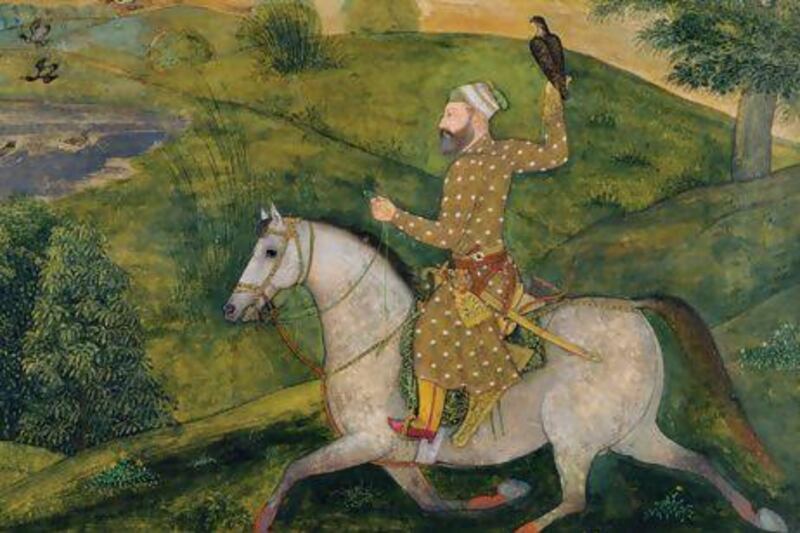The Mughals ruled as an Islamic dynasty in South Asia from 1526 to 1858. Geographically, the empire extended to most of present-day India, Pakistan, Bangladesh and Afghanistan, and is noted for its huge impact upon arts and architecture. It was also, at points, a society refreshingly tolerant of different religions and cultures - a fact also reflected in its artistic output.
Yet ask the curator, Dr Malini Roy, her favourite part of Mughal India: Art, Culture and Empire at the British Library, and she points to something far more prosaic: a painting of squirrels playfully running around a tree by the early 17th-century painter Abu'l Hasan, commissioned by the fourth emperor, Jahangir.
"You think of this opulent culture, and Squirrels in a Plane Tree doesn't immediately come to mind - even though there's plenty of gold in the painting," she laughs. "But to me what it proves is that these people gave a lot of attention to observing the world around them, and the arts sat nicely with that, whether it was architecture, painting or photography. There are so many stories behind every object here."
The Mughal India exhibition tells the story of the entire dynasty, from its beginning to its less-than-happy end.
The very first painting is a deliriously colourful image ascribed to the 16th-century painter Mahesh, depicting the early military operations of the first Emperor, Babur. The chaos of war is all too apparent, but this is a history written by the victors, and it's a vibrant, almost celebratory scene. It makes one of the last images all the more sobering: a photograph of the last emperor Bahadur Shah II in 1858 as he awaits trial for his role in the Indian Rebellion of 1857. Frail and broken like his family's empire, it's a poignant symbol of decline.
"I'm glad you noticed that," Roy says. "We've been really keen to focus on the later period of Mughal art, because it's generally been ignored. One of the great accomplishments of the Mughals was to begin a new tradition of painting, and of course Shah Jahan [1627-58] commissioned the Taj Mahal. But we wanted to break the idea that it ends there. You have to look at the empire as a whole, I think."
To that end, there's a fascinating, Bayeux Tapestry-esque depiction of the procession of Akbar II through Delhi in the early 19th century - featuring Eid revellers, elephants, camels and the British in top hats. The section of the exhibition devoted to the 15 emperors themselves is particularly revealing: it begins with colourful, happy court scenes as the empire spreads - and rules remarkably peacefully. Over a painting of his famous Red Fort in Delhi, there's a quote from Shah Jahan: "If there be paradise on earth, it is this, it is this." But it cannot last.
Tellingly, by the time Aurangzeb is emperor, he's depicted in military pose as the wars of succession and political upheaval take their toll. The section ends with the actual crown of Bahadur Shah II, purchased at auction in 1858 and sold on to Queen Victoria. There's a little note underneath revealing that it has been lent by none other than the reigning British monarch, Queen Elizabeth II.
"And if you look at today's politics in the region, it's still quite troublesome," says Roy. "I'm not advocating a return to the great period of the Mughals, but it is striking that initially they were keen to encourage this idea of tolerance between peoples - remember, this was an Islamic dynasty presiding over a Hindu majority."
And while documents in glass cases might not be as immediate as colourful paintings or golden crowns, this exhibition is also a chance for the British Library to raid its impeccable archives and offer a sense of how this dynasty lived on a daily basis - as well as provide some light relief. The Illustrated Poem for Pigeon Fanciers by Valih Musavi (1788) reveals the later Mughals did indeed like to fly their birds, and particularly enjoyed it when they "kissed". There's also a Notebook of Fragrance from 1698 - a guidebook not just for cooking up perfume and soap but arranging a house and garden.
"We did want to try and combine stunning and rare manuscripts with paintings and jewelled objects," says Roy. "Somehow, it's a relatively little-known dynasty - what we want to show is that, in terms of cultural heritage, it's up there with the very best of them."
And they do paint a good squirrel.
Mughal India: Art, Culture and Empire is at The British Library, London, until April 2, 2013





